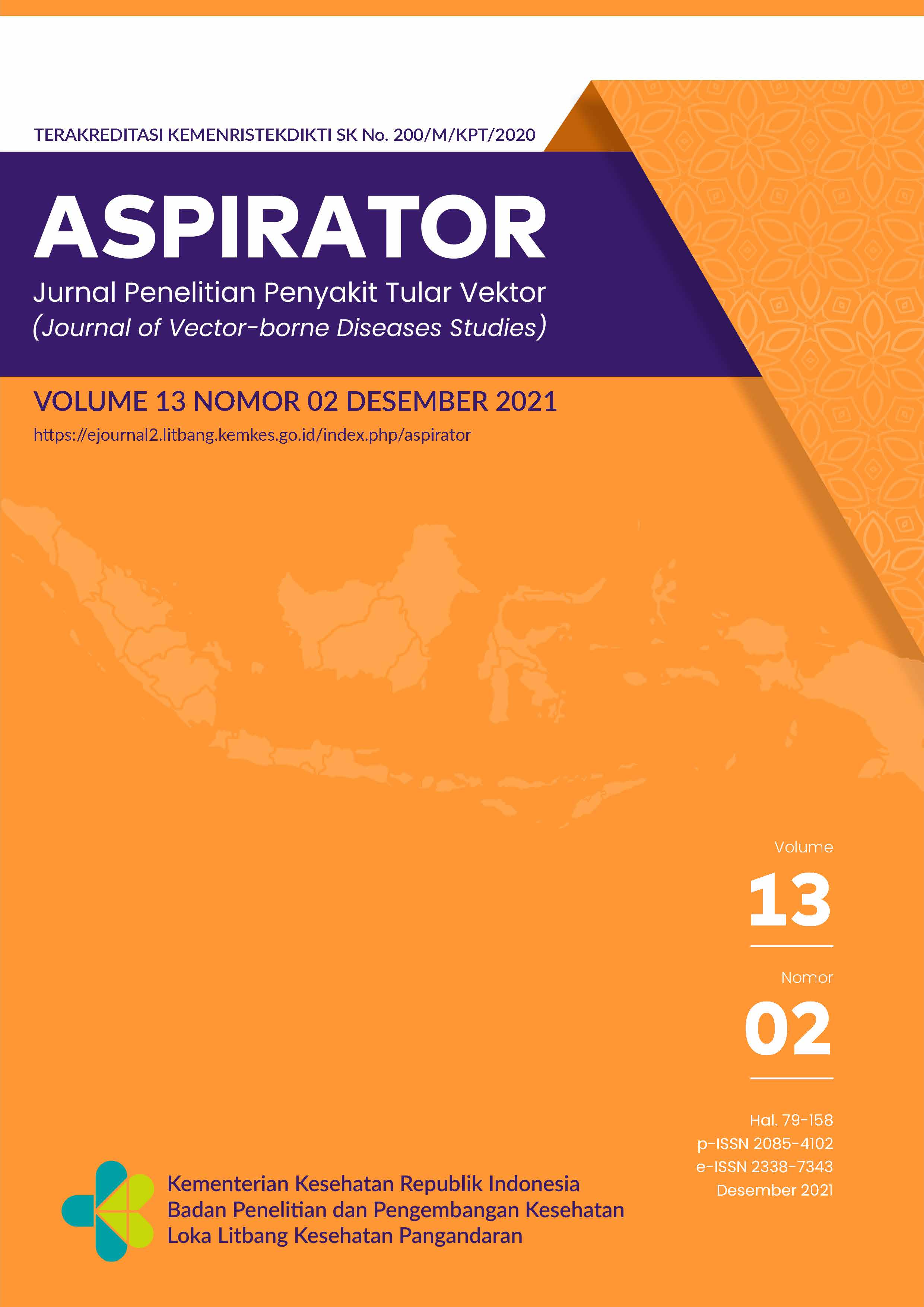Potensi Culex quinquefasciatus sebagai Vektor Filariasis dan Kondisi Lingkungan di Kota Pekalongan
The Potential of Culex quinquefasciatus as Lymphatic Filariasis Vector in Pekalongan City
Abstract
Pekalongan City was still an endemic area of Lymphatic Filariasis (LF). Twice cycles of
Mass Drug Administration (MDA) had been implemented, but the Microfi laria rate (Mf rate) was
still more than 1%. This observational research aimed to study the potential of Culex quinquefasciatus
as a vector of LF in Pekalongan City. A Cross-sectional design was chosen as an approach in compiling
information related to environmental factors and mosquitoes. The population of this research was
houses located in Jenggot and Kertoharjo village with thirty-one houses, located around fi lariasis
cases, purposively selected as samples. Variables studied in this research were environmental factors
and mosquito vectors. Data collection using observation, and laboratory examination through
mosquito dissection. Data would be analyzed descriptively. This study found that there were 8 Culex
quinquefasciatus tested positive L3 fi larial worm (infective rate 4.39%). There were 74.2% of houses
had mosquitoes’ breeding sites around them. The breeding sites were found at domestic waste disposal,
drainage in front of the house, and infi ltration well for liquid waste. As much as 86.2% of the breeding
sites contained mosquito larvae. This research concluded that Cx. quinquefasciatus was confi rmed
positive fi laria worm thus establish as mosquito vector for Lymphatic Filariasis in Pekalongan City.
The breeding sites related to the mosquito development were small water bodies, drainage in front of
and around the house.
References
2. Direktorat Jenderal Pemberantasan Penyakit Menular dan Penyehatan Lingkungan Pemukiman. Rencana nasional program akselerasi eliminasi fi lariasis di Indonesia. Jakarta: Kementerian Kesehatan RI, 2010;
3. Kementerian Kesehatan Republik Indonesia. Profi l Kesehatan Indonesia Tahun 2019. Jakarta: Kementerian Kesehatan RI, 2020; 4. Indarjo S, Siwiendrayanti A, Pawenang ET. The Community Diagnosis of Filariasis
Endemic Villages in Pekalongan City. Jurnal Kesehatan Masyarakat 2016;12(1):100–110.
5. Hamdan YL, Hadisaputro S, Suwondo A, Sofro MA, Adi S. Faktor Lingkungan Dan Perilaku Yang Berpengaruh Terhadap Kejadian Filariasis. Jurnal Ilmiah Permas: Jurnal Ilmiah STIKES Kendal 2019;9(1):21–26.
6. Dinas Kesehatan Kota Pekalongan. POMP Filariasis [Homepage on the Internet]. 2018 [cited 2020 Jan 4];Available from: htt ps://dinkes.pekalongankota.go.id/berita/popm-fi laraisis-2018.html
7. Irawan AS, Boesri H, Nugroho SS. Program Nasional untuk Eliminasi Filariasis Limfatik: Studi Kasus di Kabupaten Pekalongan, Jawa Tengah. Vektora : Jurnal Vektor dan Reservoir Penyakit 2018;10(2):95–102.
8. Munawwaroh L, Pawenang ET. Evaluasi Program Eliminasi Filariasis Dari Aspek Perilaku Dan Perubahan Lingkungan. Unnes Journal of Public Health 2016;5(3):195.
9. Rosanti TI, Mardihusodo SJ, Artama WT. Bancroftian fi lariasis transmission parameters after the fi fth year of fi liariasis mass drug administration in Pekalongan city. Kesmas 2017;12(1):22–27.
10. Nurjazuli. Entomology Survey Based on Lymphatic Filariasis Locus in the District of Pekalongan City Indonesia. International Journal of Sciences: Basic and Applied Research 2015;22(1):295–302.
11. Nurjazuli N. Entomology Survey Based on Lymphatic Filariasis Locus in the District of Pekalongan City Indonesia. International Journal of Sciences: Basic and Applied Research (IJSBAR) 2015;22(1):295–302.
12. Rahanyamtel R, Nurjazuli N, Sulistiyani S. Faktor Lingkungan dan Praktik Masyarakat Berkaitan Dengan Kejadian Filariasis di Kabupaten Semarang. JKLI 2019;18(1):8.
13. Ramadhani T, Sumarni S. Culex Quinquifasciatus sebagai Vektor Utama Filariasis Limfatik yang Disebabkan Wuchereria Bancrofti di Kelurahan Pabean Kota Pekalongan. Jurnal Ekologi Kesehatan 2010;9(3):1303–1310.
14. Ramadhani T, Wahyudi BF. Keanekaragaman dan Dominasi Nyamuk di Daerah Endemis Filariasis Limfatik, Kota Pekalongan. Jurnal Vektor Penyakit 2015;9(1):1–8.
15. Adnyana NWD, Laumalay HM, Tallan MM. Penentuan Nyamuk Anopheles spp sebagai Vektor Filariasis di Kabupaten Sumba Timur dan Sumba Barat Provinsi Nusa Tenggara Timur. Media Penelitian dan Pengembangan Kesehatan 2019;29(2):177–188.
16. Willa RW, Noshirma M. Permasalahan Filariasis dan vektornya di Desa Soru Kecamatan Umbu Ratunggai Kabupaten Sumba Tengah Nusa Tenggara Timur. ASPIRATOR - Journal of Vector-borne Disease Studies 2015;7(2):8.
17. Pahlepi RI, Santoso S, Mahdalena V, Marini M. Culex vishnui sebagai Vektor Filariasis Potensial di Kabupaten Kuantan Singingi, Provinsi Riau. ASPIRATOR 2020;12(1):1–10.
18. Annashr NN, Amalia IS. Kondisi Lingkungan dan Kejadian Filariasis Di Kabupaten Kuningan. Jurnal Kesehatan 2021;04(01):85–97.
19. Windiastuti IA, Suhartono, Nurjazuli. Hubungan Kondisi Lingkungan Rumah, Sosial Ekonomi, dan Perilaku Masyarakat Dengan Kejadian Filariasis di Kecamatan Pekalongan Selatan Kota Pekalongan. Jurnal Kesehatan Lingkungan Indonesia 2013;12(1):51–57.
20. Juhanto A, Miranti. Faktor Lingkungan Yang Berhubungan Dengan Kejadian Penyakit Kaki Gajah di Desa Kanyurang Kecamatan Liukang Kalmas Kabupaten Pangkajene dan Kepulauan. Jurnal Kesehatan Masyarakat dan Lingkungan Hidup 2020;5(1):38–45.
21. Maryen Y, Kusnanto H, Indriani C. Risk Factors of Lymphatic Filariasis in Manokwari, West Papua. Tropical Medicine Journal 2018;4(1).
22. Wulandhari SA, Pawenang ET. Analisis Spasial Aspek Kesehatan Lingkungan Dengan Kejadian Filariasis Di Kota Pekalongan. Unnes Journal of Public Health 2017;6(1):59.
23. Ikhwan Z, Herawati L, Suharti. Environmental, behavioral factors and fi lariasis incidence in Bintan district, Riau Islands Province. Kesmas 2016;11(1):39–45.
24. Juwita F, Cahyati WH, Yuniastuti A. Risk Factors of Filariasis in Brebes Regency. Public Health Perspective Journal 2020;5(2):137–146.
25. Nurjazuli N, Santjaka A. The Potential Sources of Transmission and Distribution of Lymphatic Filariasis in Semarang City, Central Java, Indonesia. Unnes Journal of Public Health 2020;9(1):43–49.
26. Ariati J, Perwitasari D, Nusa R, Marina R, Lee PA. Deteksi Mikrofi laria Wuchereria Brancrofti dan Brugia Sp Pada Spesies Nyamuk Pasca Pemberian Obat Pencegahan Massal (POPM) di Beberapa Kabupaten di Indonesia. Jurnal Ekologi Kesehatan 2020;19(3):174–183.
27. Syuhada Y, Nurjazuli, Wahyuningsih NE. Studi Kondisi Lingkungan Rumah dan Perilaku Masyarakat Sebagai Faktor Risiko Kejadian Filariasis di Kecamatan Buaran dan Tirto Kabupaten Pekalongan ( Study Of Environmental And Behavioral As Risk Factor Of Filariasis In District Of Buaran And Tirto Pekalo. Kesehatan Lingkungan Indonesia 2012;11(1):95–101.
28. Agustiantiningsih D. Praktik Pencegahan Filariasis. KEMAS: Jurnal Kesehatan Masyarakat 2013;8(2):190–197.
Copyright (c) 2021 The Authors

This work is licensed under a Creative Commons Attribution-ShareAlike 4.0 International License.











